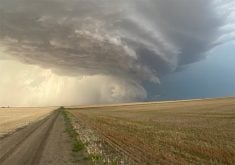If you have spent any significant time on the Prairies, you have probably experienced a hailstorm. Hail can occur pretty much anywhere across North America, but there are two main regions where chances are significantly higher. The first is the central United States. The second is the Canadian Prairies, Alberta in particular.
Can it be too warm for hail? The answer is yes. If the upper atmosphere is warm, the freezing level in the atmosphere is very high. If a thunderstorm does develop and if hail forms in the storm, the hail will probably melt before it reaches the ground.
The key ingredient for hail formation is to have plenty of cold air aloft and not too high off the ground. This is one reason why Alberta and higher elevations of the American Midwest experience more than their share of hail.
Read Also

Saskatchewan puts crown land auction on hold
Auctions of Saskatchewan crown lease land are once again on hold.
The topography of Alberta is such that, while ground temperatures can be really warm, the freezing layer is often not that high relative to what it might be in Manitoba or Saskatchewan.
Most thunderstorms will produce hail. The question is whether it will grow large enough to reach the surface without melting. With a low freezing level, the hailstone only has a short distance to fall through relatively warm air.
Another way to keep a hailstone from melting is to start with a really big one. Here is where a second common misconception about thunderstorms and hail lies. To get really big hailstones, you don’t necessarily need a really tall thunderstorm.
Hail forms when a particle passes from the warm (liquid) part of the cloud into the cold (freezing) part of the cloud. When this occurs, any water on the particle freezes. You now have a small hailstone. If that hailstone kept going up toward the top of the thunderstorm, it wouldn’t accumulate much more ice and would remain small.
For hailstones to get really big, they must drop into the warm section of the storm, pick up more water and rise into the cold section of the cloud so the water can freeze. Repeat this cycle a number of times and you can get really big hailstones.
Picture an old-fashioned bingo machine. The balls, or hailstones, are continually moving up and down due to the strong updraft.
The hard part to understand is the strength of updraft needed to keep a hailstone in the air. I looked at some equations needed to calculate this. I teach math, but at a Grade 8-9 level and, in this case, the calculations were a little beyond me. So, I asked one of the AI chat programs.
With the right series of questions, I was eventually able to come up with these numbers: a 250-gram object or hailstone, which is a little smaller than the Canadian record of 292 grams, would require an updraft of about nine metres per second. Convert that into kilometres per hour and you get an updraft of about 32 km-h.
Updrafts in thunderstorms are often in the 10 to 20 metres per second range and can, at times, approach 40 metres per second. So, the speeds needed to keep even the heaviest hailstones in the air are usually present in most thunderstorms.
If updraft speeds are not usually a problem, what limits the size of a hailstone? The answer is the size or area of the updraft and its duration. These two things determine how long the hailstone can remain in the updraft.
Pea-sized hail will do little, if any, damage to structures or plants, while golf-ball sized hailstones can destroy everything in their path.
Daniel Bezte is a teacher by profession with a BA in geography, specializing in climatology, from the University of Winnipeg. He operates a computerized weather station near Birds Hill Park, Man. Contact him at dmgbezte@gmail.com.


















